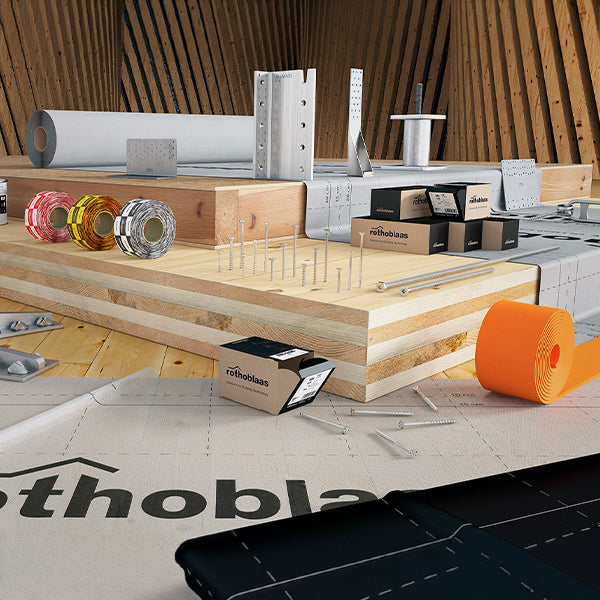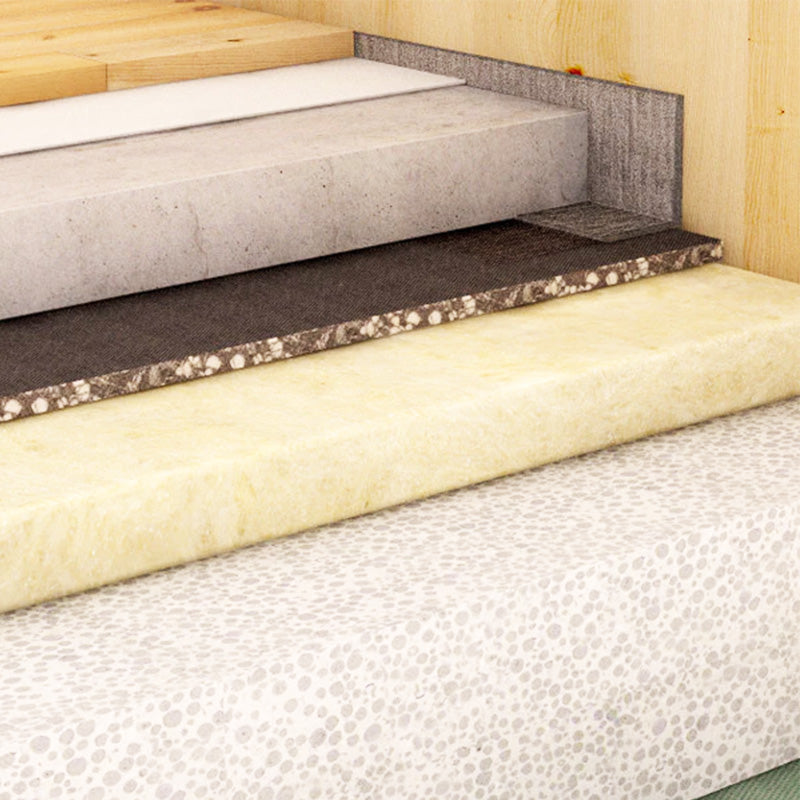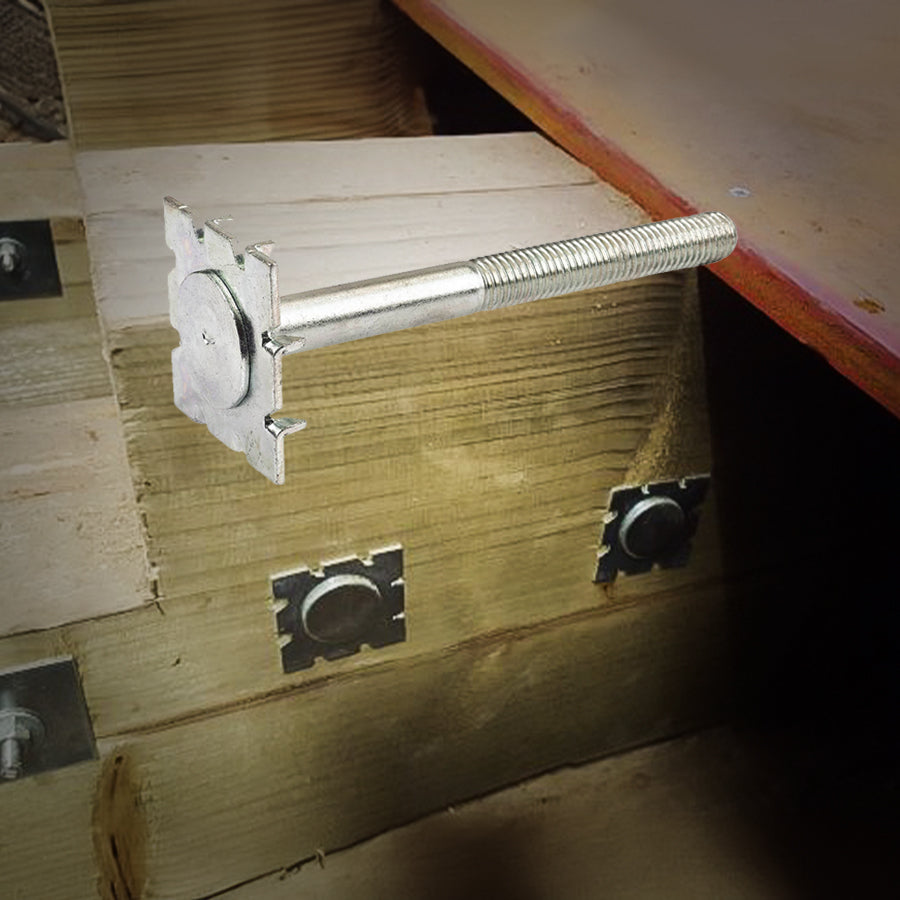
How to soundproof a timber frame house?
Understand what it takes to soundproof your timber build
Navigating the realm of soundproofing in timber frame houses often raises uncertainties among owners, builders, and architects. The question of whether effective acoustic insulation is achievable with timber construction methods persists. However, there's no need for concern, as soundproofing proves to be entirely feasible and uncomplicated in this context. Even stringent noise attenuation requirements can be easily satisfied.
Success in achieving robust acoustic insulation hinges not only on meticulous planning but also on the judicious selection and professional installation of suitable products. It becomes crucial to address secondary sound transmission paths, such as those around stairs or through plumbing, as part of the process.
Opting for building materials with a substantial bulk density emerges as a key strategy to meet acoustic insulation requirements effectively. Additionally, considering impact sound, particularly concerning ceilings, is essential.
In this guide, we will delve into the intricacies of soundproofing a timber frame house, exploring the methods, products, and considerations that ensure optimal acoustic insulation in these relatively lightweight structures.
What are the noise control challenges with wood buildings?
Wood construction buildings do offer significant acoustical issues especially the sound isolation between adjoining spaces and throughout the building. Wood tends to be lighter than concrete, which makes it harder to stop the transmission of sound.
But with the right engineering and acoustical design choices, a wood building can control its noise.
The types of sound to tackle
Researchers in sound transmission use three definitions to describe how sound travels in a building:
-
Airborne transmission:
Sound in a room generates pressure waves which induce vibration in a wall
Preventing airborne sound transmission is crucial in minimising disturbances from noises like conversations, TV, or barking dogs. When sound waves traverse the air and encounter a building element, they induce vibrations. These vibrations then travel through the structure, emerging on the other side but typically at a reduced volume.
To address this, it's essential to consider adding mass to obstruct the transmission of external noise. Contrary to concerns about increased noise in timber frame houses, the presence of additional cavity insulation in their walls significantly diminishes the impact of outside noise. Therefore, incorporating effective insulation is a key strategy in preventing airborne sound transmission and ensuring a quieter living environment.
-
Impact transmission:
Sound created by an object striking the dividing wall – shoes on a hardwood floor would be an example of this
Preventing impact sound transmission is essential in mitigating disturbances from activities like footfall, doors banging, and furniture movement. Impact noise results from physical impacts that cause both sides of a building element to vibrate, generating sound waves. Addressing this challenge requires effective isolation methods, focusing on decoupling the two sides of walls or floors.
In the quest to prevent impact sound transmission, resilient metal channels prove valuable for attaching wallboard to timber frame assemblies, effectively absorbing sound. Enhancing mass with a double layer of soundproof board is a potent strategy, providing substantial effectiveness in most cases. Additionally, incorporating sound-absorbing insulation plays a pivotal role in reducing the transmission of impact noise, ensuring a quieter and more comfortable living space.
-
Flanking transmission:
The resulting vibrations of a noise are transmitted by a building component
To prevent flanking transmission when soundproofing a party wall, ceiling, or floor, focus on the construction of your property's walls, a critical factor in soundproofing effectiveness. Flanking transmission, where sound passes through structures independent of the targeted soundproofed one, poses a challenge. In multi-unit residential buildings, sound can travel through ceilings, floors, structural joints, and plumbing chases, especially when shared components like floorboards or concrete block walls exacerbate the issue. Key to prevention is isolation, achieved through an air gap in partition walls, preventing sharing between units. Flanking transmission involves sound causing the wall to vibrate, emphasising the need for strategic isolation methods and air gaps to create effective soundproofing solutions.
The principles for multi-layer constructions
Effective acoustic insulation is the cumulative outcome of various details, each requiring meticulous consideration. Even the most well-designed structure will not function as intended if the execution is careless. Therefore, adhering to these guidelines is imperative:
- Avoid acoustic bridges that could transmit sound between structures
- Reduce sound propagation via flanking structures
- Make sure to properly execute joints between structures
-
Wall soundproofing:
Wall soundproofing involves constructing a barrier using mass-loaded membranes, acoustic boards, and other sound-dampening materials. These dense materials absorb sound energy, reducing the transmission of sound waves through the wall. Layered drywall and insulation are often added for an additional barrier, creating a multi-layered approach to effective soundproofing.
Wall soundproofing offers various benefits, including reducing external noise to enhance concentration at home or in the office, creating a more comfortable environment, and potentially improving sleep quality. It also safeguards against internal noise sources like loud music or hobbies, fostering harmony among roommates or family members. Additionally, soundproofing contributes to protecting against potential health risks associated with prolonged exposure to loud noises, such as hearing loss.
When selecting wall soundproofing, key considerations include choosing a material based on the desired level of sound reduction—opting for solutions like the GenieClip with SBX board upgrade for extreme soundproofing needs. Thickness is crucial, with higher-performing options offering better insulation at the expense of more space. Installation costs should be factored in, especially for solutions requiring professional expertise. Additionally, aesthetic appeal is important, as some materials may be visually more pleasing. Thoroughly weighing these factors ensures the optimal wall soundproofing solution is chosen.
-
Floor soundproofing:
Floor soundproofing entails utilising materials to absorb and redirect sound waves, aiming to diminish the transmission of sound through the floor into adjacent rooms. Common materials include rubber, cork, foam, and acoustic boards, which absorb sound and decrease its amplitude. Special soundproofing membranes serve as barriers when applied to the floor, preventing sound from passing through. Incorporating air-gaps, acoustic sealant, and heavy insulation additionally aids in minimising sound transmission. The combined use of these materials and techniques contributes to the creation of an effective soundproof floor.
Floor soundproofing offers numerous benefits in both residential and commercial settings. In homes, it significantly enhances the quality of life by reducing noise transmission between levels, particularly advantageous in multi-level residences or for those engaged in activities producing louder sounds. In commercial spaces, soundproofing contributes to improved acoustics, minimising noise pollution and aiding employees in maintaining focus. Furthermore, floor soundproofing can lead to energy cost savings by preventing heat loss through the floorboards. Overall, adopting floor soundproofing presents a diverse range of advantages, making it an ideal choice for enhancing living spaces and businesses alike.
When selecting floor soundproofing, it's crucial to consider the type of material, with options like rubber and cork excelling in sound blocking. The available space and existing flooring type are essential factors, as different floors require specific materials and techniques. Opt for soundproofing materials that are fireproof, water-resistant, and durable. Additionally, factor in cost, installation requirements, and the availability of professional services. Thorough research and consideration of these factors are key when choosing effective floor soundproofing solutions.
-
Ceiling soundproofing:
Ceiling soundproofing minimises the transmission of noise between spaces by incorporating acoustic insulation materials. These materials are installed between the ceiling and the room above, as well as between the ceiling joists. Acoustic insulation is designed to absorb and deflect sound waves, decreasing noise traveling through the ceiling. Enhanced soundproofing performance is achieved through the use of sound-blocking materials and systems, such as acoustic boards, hangers, and brackets. These components create a barrier, preventing sound waves from passing through the ceiling. Additionally, sealing gaps or openings in the ceiling further aids in reducing sound transmission.
Ceiling soundproofing offers significant benefits in reducing noise transmission between rooms. Improved sound quality, decreased noise pollution, and enhanced privacy are among the advantages. This method prevents sound travel between rooms and minimises external noise intrusion. It effectively reduces the transmission of appliance noises, like those from a washing machine or vacuum, to other areas. Additionally, ceiling soundproofing diminishes echoes and reverberation, leading to an overall improvement in sound quality and providing increased privacy for focused work or concentration. In essence, soundproofing the ceiling is an effective solution for reducing noise pollution and enhancing privacy within the home.
Selecting ceiling soundproofing requires consideration of the specific materials needed, including acoustic boards, brackets, hangers, and insulation. Factors such as the room size and desired level of soundproofing are crucial considerations. Careful planning for the installation process is necessary, taking into account the existing ceiling structure and material composition. Additionally, assessing the cost of both the soundproofing material and installation is important, along with evaluating any potential health risks associated with handling the materials.
Timber Build Soundproofing products
There are many soundproofing products that can be used on timber framed buildings and choosing the right one for your requirements is key to achieving the desired soundproofing performance.
These are some of the main soundproofing products that you should consider:
-
Membranes & Barriers
Explore our collection of soundproofing membranes and barriers tailored specifically for timber constructions. These meticulously designed and rigorously tested solutions ensure top-notch soundproofing performance, each presenting unique advantages. Discover market-leading products such as the Rothoblaas Vaporvlies, Traspir, and Clima membranes, each offering varying degrees of soundproofing effectiveness, along with other high-performance options. Delve into our range to find the optimal soundproofing membranes and barriers for your needs.
-
Spoundproof Panels
At the core of many soundproofing solutions are panels designed for soundproofing and sound absorption. These panels function by blocking, reducing, and absorbing sound. Whether you seek top-tier acoustic paneling for noise reduction in residential or commercial settings, or budget-friendly panels to minimise sound between rooms, we offer ideal solutions for your needs. Our soundproofing panels are available in various sizes, thicknesses, and materials, allowing you to select the perfect fit for your specific requirements. Experience a quieter and more peaceful environment with our soundproof panels.
-
Acoustic Insulation
Implementing soundproof insulation can significantly contribute to establishing a serene atmosphere. Acoustic insulation operates by capturing sound waves and inhibiting their transmission through walls, ceilings, and other solid surfaces. Our diverse range of acoustic insulation offers solutions for noise reduction in various spaces. Whether you require insulation for walls, ceilings, or floors, we have an array of products available in different densities, sizes, and thicknesses to meet your needs.
-
Tapes & Bands
Recognising the significance of soundproofing in insulation, we emphasise the importance of incorporating numerous layers of thermal and acoustic insulation for enhanced overall performance. Our array of tapes and bands caters to a wide range of applications and projects, from acoustic bands to UV-resistant tapes. Our product lineup includes options like transparent tape, double band tape, UV facade band, underfloor tape, expand band, speedy band, GIPS band, frame band, and more. Count on us to provide the essential tools required to elevate your soundproofing efforts to the next level.
-
Specialist Underlays
Specialised soundproof floor underlay is specifically engineered to minimise the transmission of sound through a floor. Its functionality involves establishing a barrier between the floor and subfloor, effectively absorbing sound waves and vibrations. Our range of soundproofing acoustic underlays is crafted from diverse materials and is compatible with various flooring types. With a selection of thicknesses, you can discover the ideal underlay to attain the desired soundproofing effect.
-
Accessories
Explore our extensive selection of soundproofing accessories to ensure a successful project. Whether you require items such as outdoor or premium glue, air glue primer spray, or silent foam/hermetic foam, peruse our range to facilitate a seamless construction process. With top-tier products and materials in stock, you can trust us to meet all your soundproofing requirements with quality assurance.
Find the right products
-

Rothoblaas Range
View range -

Soundproofing range
View range -

Joyner Bolts
View product
Need advice on your soundproofing project?
If you need any help or advice on the best soundproofing for your timber build then talk to one of our experts. They can answer any questions but also advise you on best soundproofing solution for your requirements. Just contact us when you ready to find out more.



